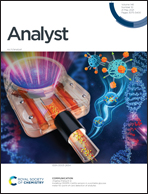Aerosol-assisted nanostructuring of nickel/cobalt oxide thin films for viable electrochemical hydrazine sensing
Abstract
Herein, we report the fabrication of NiO–CoO films for the electrochemical detection of hydrazine. An electrochemical sensor was devised where aerosol assisted chemical vapor deposition (AACVD) was employed as a nifty method for synthesizing NiO–CoO films over FTO electrodes. NiO–CoO-nanoparticle (NP) and NiO–CoO-nanowall (NW) films were fabricated over FTO substrates. The electrocatalytic analysis was performed in a standard three-electrode electrochemical setup. NiO–CoO-NW/FTO showed enhanced electro-oxidation for hydrazine at all concentrations tested. XRD, XPS, EDX, and FE-SEM techniques were used to characterize the structural, morphological, and elemental properties of NiO–CoO films. The results showed improved sensitivity, a large dynamic range, and good long-term stability of NiO–CoO-NW films. The amperometric response was used to measure the detection limit, and it was as low as 0.01 μM, and the sensitivity is ∼33 μA μM−1 cm−2. Besides, the NiO–CoO-NW/FTO electrodes showed significant selectivity towards hydrazine upon testing cross-sensitivity to other common interfering molecules. This strategy of using NiO–CoO-NW/FTO electrodes prepared via AACVD has great potential for the direct determination of hydrazine in environmental sensing applications.



 Please wait while we load your content...
Please wait while we load your content...